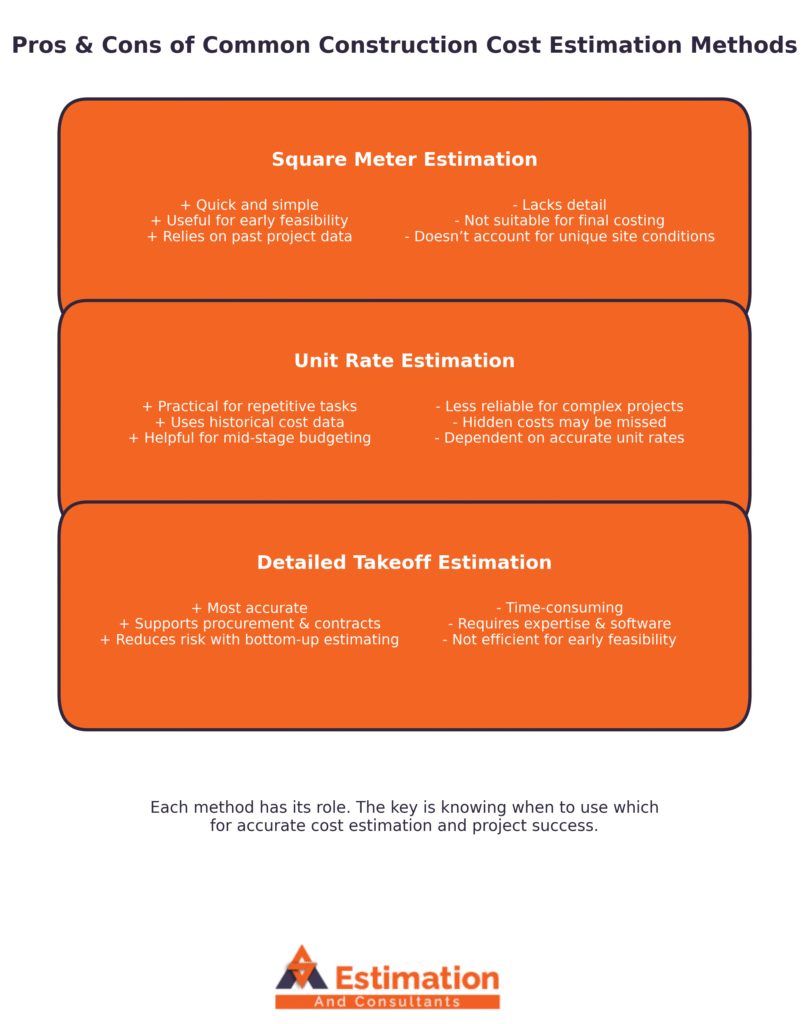The reason why accurate construction cost estimation shapes project success comes down to one simple truth: projects succeed when finances are clear from the start. Reliable estimates determine feasibility, set realistic budgets, and provide essential risk management. Without them, construction projects risk overruns, delays, and unnecessary stress for everyone involved.
The cost estimation process is more than just predicting numbers. It blends industry data, professional expertise, and project management practices to forecast construction costs with confidence. Accurate construction cost estimation not only safeguards budgets but also strengthens trust, improves decision-making, and increases the likelihood of successful project outcomes.

Understanding Estimation in Construction Projects
Cost estimation is the foundation of every successful construction project. It provides a clear forecast of expenses, helping stakeholders decide whether a project is feasible before committing resources. Beyond just numbers, estimation guides decision-making throughout the project lifecycle, shaping budgets, timelines, and long-term outcomes.
In practice, cost estimating is both a science and an art. The science comes from data-driven tools, statistical models, and construction management standards, while the art lies in professional judgment gained from experience on past projects. By combining available data with industry expertise, estimators deliver accurate and reliable construction costs that clients can trust. Now that we’ve explored the role of estimation in the project lifecycle, let’s look at the three most common construction cost estimation methods and understand when each should be used.
Method 1: Unit Rate Estimation
Unit rate estimation breaks down project costs into measurable units, such as cost per cubic yard of concrete, per square meter of tiling, or per labor hour. It’s a straightforward way to prepare a preliminary estimate, widely used by construction professionals for budgeting small to mid-sized projects.
This method is practical for trades like Masonry Estimates, Carpentry Estimates, or Painting Estimates, where repetitive tasks make unit rates reliable. By relying on cost data and historical records, project managers can quickly generate reliable estimates. However, it may fall short in complex projects where unique designs, site conditions, or specialized materials create variables that a simple unit cost cannot capture.
Where Unit Rate Estimation Works Best
- Small to Mid-Sized Projects – Ideal for homes, renovations, or extensions where tasks are predictable.
- Repetitive Tasks – Works well for brickwork, flooring, or plastering where unit rates remain consistent.
- Budget-Friendly Approach – Provides fast preliminary estimates without heavy investment in detailed takeoffs.
- Historical Data Use – Relies on existing cost data, making it efficient for comparative planning.
- Ease for Project Managers – Allows quick communication of construction costs during early discussions.
Why Unit Rate Estimation Matters
Unit rate estimation matters because it gives stakeholders an accessible way to understand costs early in a project. By simplifying figures into per-unit costs, it creates a bridge between technical estimating practices and client understanding. While not as precise as detailed takeoffs, it provides a practical starting point for financial planning.
Method 2: Square Meter (Square Foot) Estimation
Square meter (or square foot) estimation is one of the most common ways to prepare a quick cost forecast in the early stages of a construction project. By applying a cost per unit area, project managers can provide clients with a preliminary budget that helps assess overall feasibility.
This method works by drawing on past projects and comparative analysis. Construction professionals use historical data from similar projects to estimate costs based on square footage. It’s especially effective during feasibility studies when clients need an early-stage financial picture before committing to detailed designs. However, while efficient, it is not accurate enough for final costing because it does not account for unique project complexities.
Where Square Meter Estimation Adds Value
- Early Feasibility Studies – Provides fast insights into whether a project is financially viable.
- Budget Discussions – Helps stakeholders align on a ballpark budget at the concept stage.
- Comparative Analysis – Relies on data from past projects to create realistic projections.
- Quick Client Decisions – Supports faster go/no-go decisions without extensive analysis.
- Project Planning – Gives a broad understanding of construction costs before detailed estimating.
Why Square Meter Estimation Matters
Square meter estimation matters because it allows decision-makers to quickly gauge whether a project is worth pursuing. It provides a financial baseline during the concept stage, ensuring time and resources aren’t wasted on unfeasible ideas. While not a final answer, it plays a critical role in early-stage project planning.
Method 3: Detailed Takeoff Estimation
Detailed takeoff estimation is the most thorough approach, involving a line-by-line breakdown of every material, labor hour, and equipment requirement in a project. Unlike preliminary methods, this approach delivers a detailed estimate that project managers can confidently use for contracts, procurement, and final budgeting.
This method is best suited for high-value or complex projects where accuracy is critical. By using a bottom-up estimating method, estimators can minimize risk and ensure proper cost control. Modern construction professionals often rely on specialized cost estimating software to handle quantity takeoffs, giving them both precision and efficiency when preparing detailed estimates.
Where Detailed Takeoff Estimation Adds Value
- Large or High-Value Projects – Provides the level of accuracy needed for multi-storey buildings, commercial sites, or infrastructure.
- Final Budgeting – Ensures precise allocation of costs for procurement and contract agreements.
- Risk Reduction – Identifies hidden costs early and reduces chances of budget overruns.
- Supplier Negotiations – Breaks down material and labor requirements, supporting better pricing discussions.
- Project Control – Offers project managers reliable numbers to track and manage costs during execution.
Why Detailed Takeoff Estimation Matters
Detailed takeoff estimation matters because it provides the highest level of accuracy in construction cost planning. By breaking projects down to the smallest detail, it ensures reliable budgeting, supports procurement, and reduces risk. With the help of digital takeoff software, this method gives project managers a dependable financial picture for confident decision-making.
Comparative Analysis: When to Use Each Method
Every construction project moves through different stages, and the right estimation method depends on where you are in the project lifecycle. Square meter, unit rate, and detailed takeoff methods each serve a unique role — from quick preliminary checks to final accurate estimates. Understanding when to apply each ensures better project planning, risk management, and cost control.
Professionals often combine these approaches. A project might start with square meter estimates for feasibility, shift to unit rate estimates during budgeting, and rely on detailed takeoff at execution. This layered method ensures clients receive estimates that are both practical and reliable across the entire construction journey.
Comparative Analysis Table: Matching Methods with Project Stages
| Estimation Method | Best Project Stage | Pros | Cons | Accuracy Level |
| Square Meter (Square Foot) Estimation | Concept / Feasibility Stage | – Quick preliminary estimate- Uses past project data- Helps early client decisions | – Lacks detail- Doesn’t account for unique project conditions | ⭐⭐ (Low to Medium) |
| Unit Rate Estimation | Budgeting / Mid-Stage Planning | – Practical for repetitive tasks- Relies on cost data and historical trends- Useful for comparative analysis | – Not ideal for highly complex projects- Can miss hidden costs | ⭐⭐⭐ (Medium) |
| Detailed Takeoff Estimation | Execution / Final Stage | – Most accurate method- Comprehensive material and labor breakdown- Supports procurement and contracts- Reduces financial risk | – Time-consuming- Requires expertise and software tools | ⭐⭐⭐⭐ (High) |
Why Expertise and Professional Guidance Matter in Cost Estimation
Cost estimation may look straightforward on paper, but relying only on basic numbers can create serious risks for a project. Without expert oversight, even a small miscalculation in materials, labor, or equipment can lead to budget overruns and delays that impact overall project success.
Professional guidance brings more than just numbers. Experts combine years of industry knowledge with advanced tools, including artificial intelligence and digital takeoff software, to produce reliable estimates. This blend of human expertise and technology ensures risk management, accuracy, and trustworthiness that quick, informal estimates simply cannot provide.
Why Expert Oversight Makes the Difference
- Accurate Forecasts – Experts refine preliminary estimates into reliable budgets tailored to your project.
- Risk Management – Professional estimators identify hidden costs and reduce financial uncertainty.
- Use of AI & Tools – Digital platforms and artificial intelligence improve accuracy and speed.
- Experience-Based Insight – Years of industry practice allow experts to apply judgment beyond raw data.
- Reliable Results – Clients receive detailed, trustworthy numbers that support decision-making and project success.

Frequently Asked Questions
The most common method of construction cost estimation depends on the project stage. Square meter estimates are often used for early feasibility, unit rate estimates are applied for budgeting, and detailed takeoff estimates are preferred for final costing. Each method has its place in the project lifecycle.
You shouldn’t rely only on square meter estimates because while they are useful for quick feasibility checks, they don’t capture project-specific details. Every site condition, material selection, and design feature can change costs. That’s why experts recommend moving to detailed takeoff estimates for reliable and accurate budgeting.
A detailed takeoff estimate is very accurate because it breaks down every material, labor task, and equipment requirement. By using quantity takeoff methods and cost estimating software, professionals can create reliable cost forecasts. This level of accuracy reduces financial risks and gives clients confidence in their project budgets.
Yes, you can mix different cost estimation methods in one project because each serves a different purpose. Square meter estimates help at the concept stage, unit rates support mid-stage budgeting, and detailed takeoffs ensure accuracy at execution. Combining methods provides reliable estimates across the entire project lifecycle.
You need professional guidance for cost estimation because experts combine experience, data, and advanced tools to deliver reliable estimates. Without expert advice, small errors in early estimates can lead to major overruns. Professional oversight ensures better risk management and helps projects stay on budget from start to finish.
Conclusion: Blending Methods for Reliable Cost Estimates
Accurate cost estimate is more than just numbers — it’s the foundation of project success. Square meter estimates help with early feasibility, unit rates assist in budgeting, and detailed takeoffs provide the accuracy needed for execution. When blended thoughtfully, these methods save time, reduce stress, and support strong cost control.
At AS Estimation & Consultants, we bring reliability and expertise to every project. Our team of construction professionals uses proven methods, advanced tools, and industry knowledge to deliver accurate cost estimation that clients can trust. If you’re planning a construction project, let us provide tailored, expert-backed estimates that give you clarity and confidence from start to finish.


